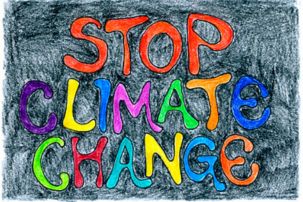Lesson summary
In this activity students are asked to explore how and what they personally think about climate change and to create an artwork that represents how they feel. Students begin by thinking of one word that they associate with climate change and then create a mind map to interrogate the reasons behind why they chose this word. Students then create an artwork based on their word and mind map and present it to the class.
Learning intentions:
Students will...
- understand that climate change is a challenging and complex issue
- understand that there are many different ways of thinking about climate change
- recognise that art can be used to interrogate how we think about and respond to issues like climate change
- understand that art should portray a message or a meaning that can be understood and interpreted by the audience.
Lesson guides and printables
Lesson details
Curriculum mapping
Australian Curriculum content descriptions:
Year 7 English:
- Use interaction skills when discussing and presenting ideas and information, selecting body language, voice qualities and other elements, (for example music and sound) to add interest and meaning (ACELY1804)
- Plan, draft and publish imaginative, informative and persuasive texts, selecting aspects of subject matter and particular language, visual, and audio features to convey information and ideas (ACELY1725)
- Use a range of software, including word processing programs, to confidently create, edit and publish written and multimodal texts (ACELY1728)
Year 8 English:
- Use interaction skills for identified purposes, using voice and language conventions to suit different situations, selecting vocabulary, modulating voice and using elements such as music, images and sound for specific effects (ACELY1808)
- Create imaginative, informative and persuasive texts that raise issues, report events and advance opinions, using deliberate language and textual choices, and including digital elements as appropriate (ACELY1736)
- Use a range of software, including word processing programs, to create, edit and publish texts imaginatively (ACELY1738)
Year 7 & 8 Visual Arts:
- Experiment with visual arts conventions and techniques, including exploration of techniques used by Aboriginal and Torres Strait Islander artists, to represent a theme, concept or idea in their artwork (ACAVAM118)
Syllabus Outcomes: EN4-2A, EN4-3B, EN4-4B.
Time required: 60 mins
Level of teacher scaffolding: Low – oversee activity
Resources required
- Internet access
- Student worksheet
- Materials for artworks – photography/photo montage (camera, photo editing program, montage materials), movie/animation (movie editing program, animation creation program), music (music recording program), painting/drawing (art materials), graffiti (art materials), textiles (art materials), sculpture (art materials), comic strips (art materials), story (writing materials), mood board (art materials).
Additional info
This is an original Cool.org lesson. Facts and figures in these lessons may have changed since this lesson was published. We always endeavour to update our resources in a timely manner, but if you see an error or issue in our resources please get in touch with us.


Welcome back!
Don't have an account yet?
Log in with:
By signing up to Cool.org you consent and agree to Cool's privacy policy to
store, manage and process your personal information. To read more, please see
our privacy policy here(Opens in new tab).
Create your free Cool.org account.
Many of our resources are free, with an option to upgrade to Cool+ for premium content.
Already have an account?
Sign up with:
By signing up to Cool.org you consent and agree to Cool's privacy policy to
store, manage and process your personal information. To read more, please see
our privacy policy here(Opens in new tab).